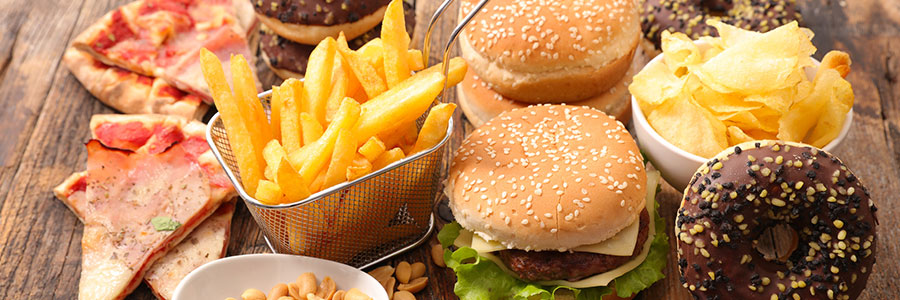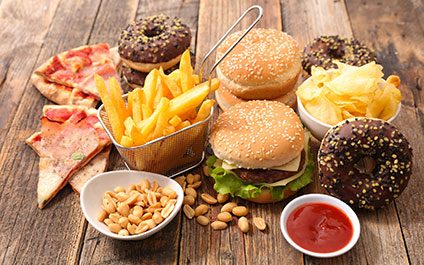

America loves fast food, and that’s not something most of us are proud of.
According to a 2013 report from the National Center for Health Statistics (NCHS), Americans consumed about 11.3 percent of their total calories from fast food from 2007 to 2010. That’s a lot of hamburgers, fries, and milkshakes.
There’s some evidence that we’re gradually changing our habits. The fast-food industry showed no traffic growth in 2016, and in the same year, soda consumption fell to a 30-year low.
Still, while we’d love to swear off fast food once and for all, it’s often the easiest option, and during a busy work week, convenience means something.
Instead of making promises we can’t keep, we reached out to several nutritionists, dietitians, and fitness coaches to find out which fast food items deserve a hard pass when we do end up in the drive-thru. Again.
Here’s what we found.
- Beware of the salads. If you’re trying to eat a healthy diet, you might decide to avoid burgers and chicken sandwiches in favor of a delicious salad. After all, what’s healthier than vegetables?
Quite a few things, it turns out.“When ordering salads, always get the dressing on the side and add in only a limited amount,” says Laura Arndt, NSCA-CSCS.
Arndt is the CEO of Matriarc, a company that specializes in pregnancy and postpartum health. She has a degree in exercise science and is a certified personal trainer. She notes that restaurants often over-dress their salads for an obvious reason: It tastes good.
Take, for example, McDonald’s Southwest Grilled Chicken Salad. With 350 calories and 9 grams of sugar, it’s far from the worst item on the chain’s menu. Add in a packet of the Newman’s Own Creamy Southwest Dressing, though, and you’re looking at another 120 calories, 3 grams of sugar, and 8 grams of fat.
The simple solution is to cut down on the amount of dressing you use.
“You do not need the entire packet of dressing to still have the flavor,” Arndt notes. Sure, you’ll feel a bit wasteful as you throw away that half-used packet of dressing, but your waistline will thank you.
- Flavored coffee drinks are typically packed with sugar. Sticking with coffee? Watch out for flavored brews. After all, that “flavor” has to come from somewhere. “Flavored coffees, smoothies, and beverages tend to be very high in sugar and low in nutrients,” Arndt says. “Order your drinks plain, with skim or low-fat milk, and add your own flavoring.”
Research your choices before you order. Starbucks’ Vanilla Sweet Cream cold-brew coffee, for instance, has about 110 calories per grande serving. The numbers quickly add up if you’ve got a mean caffeine habit, so if possible, start taking your coffee black. - Oh, and you really don’t want to get addicted to blended drinks. “Avoid milkshakes, Frappuccinos, and McFlurries,” says Janis Isaman, nutrition coach and owner of Calgary-based My Body Couture, a private fitness studio.
That’s not an exaggeration. A venti serving of Starbucks’ Salted Caramel Mocha Frappuccino packs in 570 calories, 470 milligrams of sodium, and 92 grams of sugar.
Isaman goes on to say, “High-calorie foods are … on my list of things to avoid, but highly caloric hamburgers at least include some useful nutrients, whereas I simply don’t see the nutritional value in any of these drinks, which can have upwards of 750 calories.”
You can cut some of those numbers by choosing non-fat milk and skipping the whipped cream, but as Isaman points out, what’s left is still mostly empty calories.
- You need to sidestep certain side dishes. This warning really applies to all sides, but fast-food coleslaw is especially nefarious, according to registered dietitian and nutritionist Susan Stalte. Stalte notes that while coleslaw might seem healthy, it’s often chock-full of unnecessary calories.
“The item that is generally a must-skip is coleslaw, specifically the one that was sold by Chick-fil-A,” she says, noting that Chick-fil-A has other options that she considers diet friendly. “It’s usually made with a ton of mayonnaise and can be almost as many calories as a meal.”
Chick-fil-A discontinued their coleslaw in 2016, releasing their recipe while announcing the move. Unsurprisingly, the side was packed with sugar. KFC currently offers a coleslaw that weighs in at a hefty 170 calories per serving.
Although Stalte isn’t a fan of counting calories, she does recommend looking at basic nutrition facts before ordering any item, even if it seems nutritious on the whole. If the item has a massive caloric load, you’ll probably want to avoid it, regardless of how much cabbage you see on the plate.
- Don’t treat lunch meats as a safer alternative to burgers. Maybe you’ll skip the burgers and pick up a nice sub sandwich. That’s a fairly healthy choice, right?Probably not. Lunch meats aren’t necessarily healthier, as they’re highly processed.
The American Institute for Cancer Research warns that processed meats can increase the risk of certain cancers. Most of those meats also have high levels of sodium, which can cause high blood pressure.“Unless you are getting the chicken breast, you are eating highly processed meat that is full of nitrites and tons of sodium,” says Hope Pedraza, a certified personal trainer (ACSM), nutrition coach (NAFC), and the founder and creator of inBalance, a fitness and wellness studio located in San Antonio, Texas.
A 6-inch cold-cut combo from Subway contains 1090 milligrams of sodium, according to the company’s website. The U.S. Food and Drug Administration (FDA) recommends consuming fewer than 2,400 milligrams of sodium per day, so lunchmeat certainly seems problematic.”
“Nobody wants high blood pressure from eating a sandwich,” Pedraza says.
According to a Canadian Broadcasting Corporation Report, A DNA testing of chicken sold at Subway restaurants in Canada revealed that two of the chain’s popular sandwiches contain chicken that is only part meat.
According to the study, which has been disputed by Subway, the oven roasted chicken tested at 53.6% chicken DNA, while soy DNA made up the rest.
Subway has since reported the study as “false and misleading,” and has sent their own samples Maxxam Analytics in Ontario and Elisa Technologies in Florida. The results from both found that less than 1% or products contain soy protein.
However, as a result of the controversy, Subway announced that it would roll out an all natural menu later this year.
- Let nature be your guide, but don’t always trust your eyes.Sofia de Campos Pereira, PhD, is a health coach at Best Health Best Life. She’s got a simple rule for eating out: Order foods that look like what you’d find in nature.”
That is, [look for] whatever foods are least processed before they were cooked and served,” de Campos Pereira says. That might mean skipping out on the chicken nuggets—or at least the fried nuggets. Grilled nuggets are less likely to use huge amounts of nitrites and sodium, and the lack of breading cuts the calorie count quite a bit.
Chick-fil-A’s fried nuggets, for instance, have roughly 260 calories and 980 milligrams of sodium per 8-nugget serving. The company’s grilled nuggets contain 140 calories and 440 milligrams of sodium.
But while de Campos Pereira says that the eye test is useful for evaluating food, it’s not perfect.
“It’s important to be aware that sometimes what we think we are eating is not at all what we are eating,” she explains, “like for example, [some] cheeses, which are almost 50 percent potato starch.”
While fast food is fast for a reason, some foods are actually pre-made, frozen or dehydrated and shipped to stores. However that doesn’t always mean that they are worse for you. According to a former Team Trainer at Taco Bell, “Refried Beans and Red Sauce are made on a prep table from mixing special dry storage ingredients and boiling water. Refried Beans need to settle in a heating cabinet for 45 minutes before being put on line, Red Sauce is ready to go immediately.
In general, canned and dehydrated beans are nutritionally comparable, but canned beans are often higher in sodium and can be slightly lower in nutrients.
To read the full article click here!

